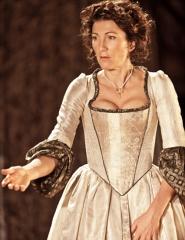The Duchess of Malfi Review 2012
Written by John Webster and first performed around 1613, 'The Duchess of Malfi' is a tragic and rather gruesome tale. A mound of bodies lie strewn on the stage at the end, and there are more murders and deaths along the way. But, even though Webster's play presents ample opportunity for the over-zealous director to take the murderous plot to extremes, Jamie Lloyd orchestrates events with rather more subtlety, even if there is a strangulation scene which seems almost endless.
The most striking feature of this production, however, is Soutra Gilmour's wonderful, towering set. It suggests the interior of a cathedral, with shafts of wood that disappear into the highest reaches above the stage. There are walkways with bannisters sporting delicate carvings, and candles provide sinister shadows where characters can skulk. The monumental effect is augmented by James Farncombe's dramatic lighting which throws huge shafts of light over the stage.
Eve Best's Duchess is beautiful and available as she is a widow. She has two brothers. One of them is a devious and scheming cardinal (Finbar Lynch) and the other, Ferdinand (Harry Lloyd) is a psychopath who, one suspects, would be happy to settle down with the Duchess himself. The brothers are aided in their scheming ambitions by an old soldier Called Bosola, a murderous thug who, almost to the bitter end, seems to relish his bloodthirsty endeavours.
The Duchess marries her steward, Antonio, in secret and in a trice she has delivered him three children, one of whom seems old enough to be in secondary school. How time flies! Bosola discovers that the Duchess is getting fat during her first pregnancy and when the child is born he informs her brothers. But she still has time to provide Antonio with two further children before her brothers take action. That forces the Duchess to plan an escape, but Bosola brings her back and while incarcerated her brother Ferdinand brings her a sawn-off hand supposedly cut from Antonio's body. And he shows her two wax figures made to look like the dead bodies of Antonio and her eldest child. Hardly brotherly love!
Mark Bonnar's Bosola seems permanently angry, perhaps with good cause. But his continual shouting irritates after a while, and would be more sinister with some quieter touches. In fact he needs to be, at least sometimes, rather more like Harry Lloyd's highly convincing Ferdinand who is quietly, but manically deranged. There's excellent support from Tom Bateman as the handsome steward, Antonio, and Eve Best as the Duchess is elegant and beautiful, even if she seems to cope rather too calmly with the news of the death of her children and husband, and indeed her own demise.
There are times when Webster's rich, evocative language seems equal to anything by Shakespeare. But there are rather too many lengthy and overly complex speeches where it is easy to lose track of just what the character intended when he started speaking. And though Webster's tale is based on a true story, it is not always clear just what drives the Duchess's evil brothers, apart from Ferdinand's obvious mental instability, and Webster's play could easily be reduced by half, without losing any of the basic story.
The production values here are of the highest order, and Jamie Lloyd admirably resists the temptation to gorge on the gore. But even then, I suspect this will all be too much for some, though it is not nearly so bloody as some versions of Titus Andronicus I have seen. The scene where the Duchess is strangled is a little hard to take, but by the end of the play the pile of bodies becomes more laughable than terrifying.
"A classical revival that delights in the original's language and period setting. And Eve Best gives a compelling performance."
Michael Billington for The Guardian
"Director Jamie Lloyd, in getting his cast to pay so much attention to the density of Webster's language, loses a sense of intrigue and malignant horror."
Henry Hitchings for the Evening Standard
"Not even the haloed Eve Best can save the Old Vic's production of the Jacobean horror-show The Duchess Of Malfi. This John Webster play is usually called a tragedy but 'snuff movie' might come closer to the truth.
Quentin Letts for the Daily Mail
"A superbly effective piece of theatre, mixing jolting shocks and pitch-black comedy with wonderful lines of ominous verse...The great Eve Best seizes all her chances here, giving a thrilling, sexy and often deeply moving performance in Jamie Lloyd's gripping, atmospheric production."
Charles Spencer for the Daily Telegraph
External links to full reviews from popular press
The Guardian - Telegraph
Originally published on
